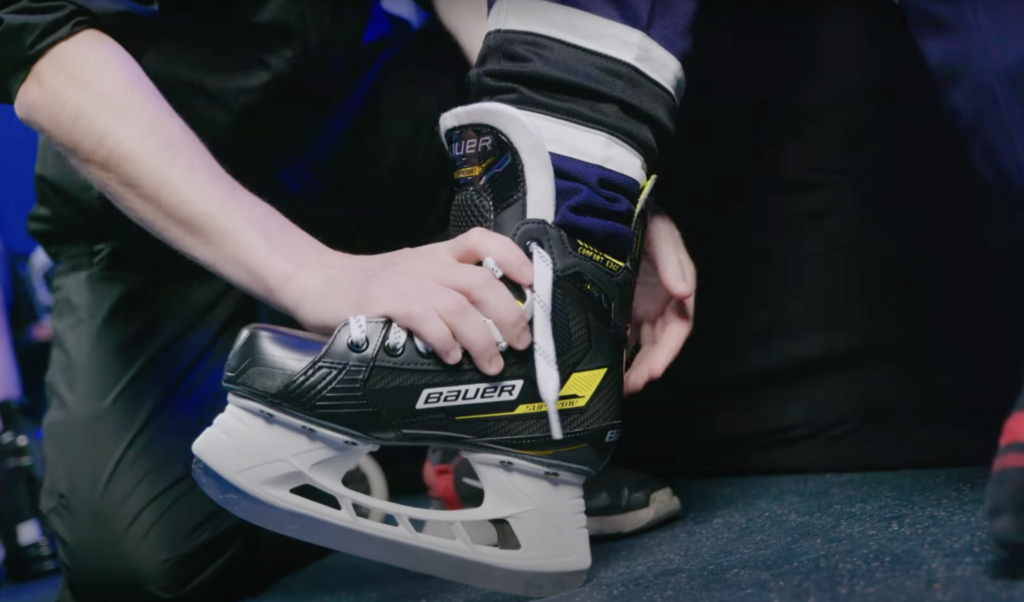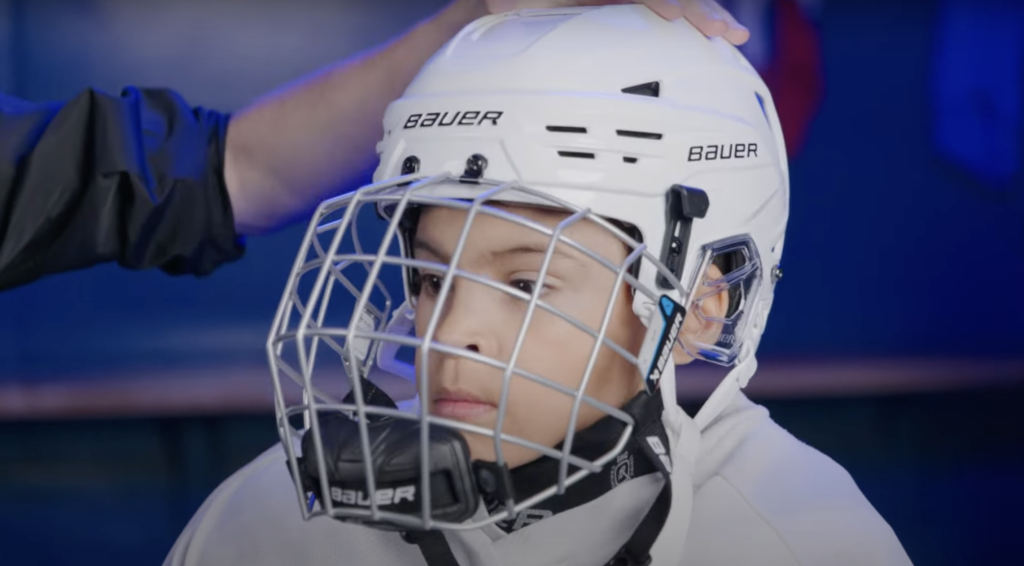September 25, 2023
Hockey Equipment: A Step-by-Step Guide to Getting Ready
Whether you’re a parent introducing your child to the sport or a newcomer eager to learn, this guide is here to help you navigate the ins and outs of hockey equipment and getting ready for the ice. Read below as we’ll take you through the step-by-step process of putting on your hockey equipment properly.
Grab your gear, get comfortable, and let’s dive into the world of hockey equipment and how to wear it like a pro.
1. Shin Pads: Protect Those Legs
Your legs are one of your most precious assets on the ice and shin pads are meant to protect them. To put them on properly, follow these steps:
• Slide the shin pads on, making sure the knee cap aligns with your knee.
• Fasten the straps securely around your leg, but don’t make them too tight.
• Ensure there’s no pressure on your foot, and double-check the fit before moving on.
Shin pads are crucial for safety and comfort, so take the time to get them right.
2. Socks: Your First Layer of Defense
Hockey socks serve more than being just a fashion statement; they provide an additional layer of protection over your shin pads. Make sure you:
• Slide the socks over your shin pads, ensuring they completely cover them.
• This extra layer will help keep everything in place and make you look like a pro out on the ice.
3. Pants: Padded Comfort
Hockey pants are the finishing touch to your lower body armor. They’re designed to absorb impacts and protect your hips and thighs. To wear them properly, follow these steps:
• Slide one leg at a time into the pants and tighten the waist to secure them.
• Make sure the padding stays in the right position, especially around your hips and thighs. Feel free to adjust if necessary.
Making sure your hockey pants are on comfortably is crucial for your safety and your overall performance on the ice.
4. Skates: Your Wheels
Your skates are your connection to the ice and you need to make sure that they are worn correctly. When putting them on, follow these steps:
• Slide your foot into the skate and kick your heel back to lock it into the heel pocket.
• Tighten the laces from bottom to top, finding the balance between snug and comfortable.
• Avoid wrapping the laces excessively around your ankle.
Many hockey players like to wrap the laces around their leg but this is actually bad for your ankle.
5. Shoulder Pads: Upper Body Security
Now that our lower half is fully complete, it is time to move on to your upper body. Keep these things in mind when you are putting on your shoulder pads:
• Put them on over your head and secure the straps around your upper body.
• Make sure they fit snugly without restricting your movement.
• Ensure they protect your collarbone and upper body effectively.
Shoulder pads are essential for safety, so find the right fit for optimal performance.
6. Elbow Pads: Guard Your Elbows
Elbow pads are crucial for shielding your elbows from falls and collisions. To wear them properly, follow these steps:
• Slide your arms through the straps and ensure a comfortable fit.
• Make sure your elbows sit snugly in the elbow caps for proper coverage.
Properly worn elbow pads not only protect you but also enhance your game by providing freedom of movement.
7. Neck Guard: Safety First
Don’t overlook the neck guard; it’s there for a reason. To wear it properly, do this:
• Ensure it’s snug but not constricting your breathing.
• Protect your neck from potential injuries like skate cuts or stray sticks.
Your neck is one of the body’s most vulnerable areas, so take the time to make sure your neck guard fits comfortably and securely.
8. Jersey: Looking the Part
Your jersey isn’t just for looks; it’s your team identity. To wear it properly, just make sure that:
• It fits comfortably; you don’t want it to be too long so that it interferes with your gloves.
A well-fitted jersey not only represents your team but also keeps you comfortable on the ice.
9. Helmet: Your Most Important Piece
Your helmet is your ultimate protection and is a mandatory piece of equipment when playing hockey. To wear it properly, follow these steps:
• Position it about a finger’s width above your eyebrows.
• Ensure the cage is properly attached without being too tight against your jaw.
• Secure the chin strap to prevent the helmet from coming off during play.
Your helmet is non-negotiable; it must fit securely to keep you safe on the ice.
10. Gloves: Grab onto the Game
Gloves keep your hands safe from sticks, pucks, and the elements. To wear them properly, follow these steps:
• Slide your fingers into each finger hole.
• Ensure a snug fit without sacrificing mobility.
• Leave a little space at the front and make sure your wrists are adequately covered.
Well-fitted gloves are not only essential for dexterity and protection during play, but also will impact your overall performance.
11. Stick: Your Twig
Before you hit the ice, take a moment to tape your hockey stick. There are two areas that you will want to tape:
• The blade of your stick to help you with overall puck control.
• The knob at the top of the stick to prevent accidents on the ice and give you a better grip.
With all your gear properly in place, you’re now ready to step onto the ice and embrace the thrilling world of hockey. Remember, comfort, mobility, and safety are paramount. Take your time adjusting your equipment to your liking.
Feel free to check out our YouTube video here for a more comprehensive guide on hockey gear and getting ready for the rink.

